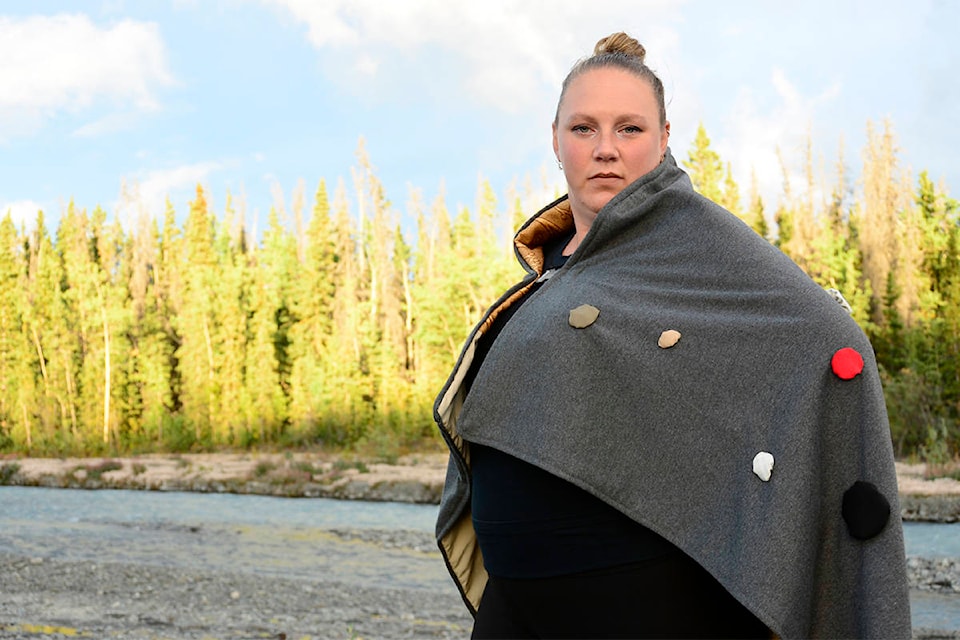It’s easy to tell a story in words, or paint a sense of place with a picture, but can you do that with clothing?
Henry Navarro does.
Navarro is the visiting artist taking part in the Junction Artist in Residence program in Haines Junction. A fashion professor at Ryerson University in Toronto, his artistic practice focuses on site-specific projects that fuse public art and fashion design to explore larger issues in communities.
“Since 2009 I started working as a public artist by using fashion as a medium,” he said. “It works very well in terms of creating connections. Fashion is something that is close to people because they get dressed every day.”
Navarro came to fashion in a roundabout way. He grew up in a family of dressmakers and leather workers, then went to school for fine art, where he specialized in sculpture and public art. From there, he found work as an art director for a variety of theatres, while simultaneously working as a visual artist.
“They were kind of going in parallel,” he said. “They were borrowing a lot from one or the other and I was at a point where I decided the only way forward was to consolidate them.”
Navarro has previously used this medium to explore the social and cultural complexities of communities in Spain, Italy, the U.S., Canada and Cuba.
When he applied to the residency in Haines Junction, he took the same approach to the Yukon that he took during the making of those collections, which was to let go of his own ideas and perceptions.
“I do nothing before I get to the site,” he said. “I don’t want to get any story ideas or interpretations of the place or the people or the culture where I’m going to, so nothing in the design process starts before I get there.”
Since arriving in the Yukon in June, he has taken cues from people he has met in Haines Junction.
Residents of all ages, from five to 65 years old, from Champagne and Aishihik as well as the Kluane First Nations, have met with him to talk about what’s important to them. Some want to talk about fashion and what it means to them. Others want to talk about place, and what it does to them — how it informs their lives.
Occasionally they drive him to see certain places. Others just make suggestions. That’s how he’s ended up visiting the Kluane Lake Research Station and the Long Ago People’s Place, both locations that resonated with him.
“It wasn’t a visual experience. It was more an energy experience. There’s something very strong in there that I could feel something different after being there. It was almost like I fully got to truly understand what Yukon and what this area is like after spending time in there.”
Navarro said he also likes that the Haines Junction residency has a community focus to it. While he’s been working on his own collection the last three months, he has also kept hours at the Da Kų Cultural Centre. Residents of Haines Junction have come to him with their own ideas, and he’s been happy to offer advice on everything from marketing, to merchandising, to figuring out their own creative processes.
“I like that this program makes possible that type of exchange,” he said. “It’s not just that the artist comes and gets all the goodies and goes away.”
Though he has had plenty of goodies too, he said. He has worked with leather in the past, but never fur. In Haines Junction, he has incorporated bison fur into some of his designs, which means he’s had to consider colour, texture, and the grain of the fur when it comes to cutting.
He’s taking a holistic approach in terms of conserving by cutting materials in such a way that waste is minimized.
In doing so, Navarro said he’s found that fur helps him convey the contrasts inherent in the North — where the wilderness can be beautiful, but dangerous too.
“One approach was contrasting the different materials I use but also contrasting the perceived functions and uses of certain types of garments,” he said.
“Leather, it still feels a bit man-made. Fur, it feels animalistic. If you want to recall something wild, fur is better for that, and I think one of the main aspects of Yukon life is how close wildlife is to us here.”
In this way, he said he aims to interpret the animals, plants, geological formations, and architecture characteristic of the area. It’s subtle, he said. He’s not looking to capture the likeness of animals or mountains, but rather their symbolism and significance.
For example, a pair of motorcycle leggings and a short jacket represents the raven. Instead of being all black, with feathers, Navarro used red and black for the stitching, and sewed an outfit that looks a little like a superhero costume because, Navarro said, the raven brings the sun, and you’d need super powers to do something like that.
Navarro’s complete collection, called The Junction Collection, will be presented during a gala on Oct. 13 at the St. Elias Convention Centre. There is a 6 p.m. community potluck and reception, follows by a fashion show at 7:30 p.m. The event is free.
Contact Amy Kenny at amy.kenny@yukon-news.com
